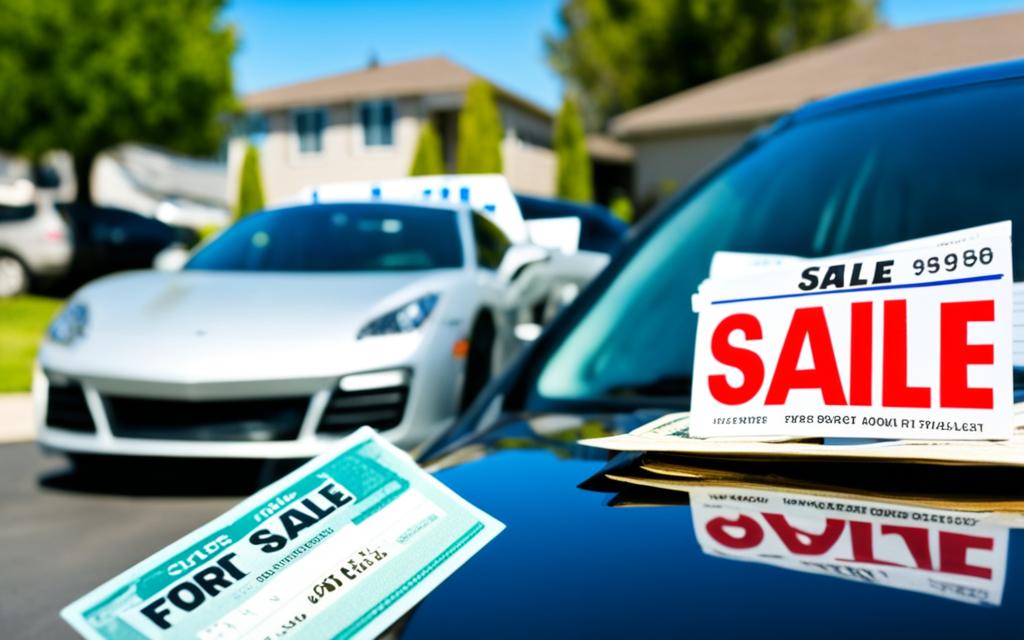Are you considering trading in your car but still have outstanding loan payments? Understanding the options available to you is crucial. In this article, we will delve into the process of trade in a financed car and provide valuable insights to help you make informed decisions.
Key Takeaways:
- Trading in a financed car is possible, but it’s essential to know the process and your available choices.
- Negative equity can impact your trade-in options, so it’s important to understand how it affects your situation.
- Researching trade-in valuations and preparing your car for trade-in can help you maximize its value.
- Consider other trade-in options, such as private sales or lease buyouts, to find the best solution for your needs.
- Navigating the trade-in process involves understanding the steps, negotiating effectively, and handling outstanding loan balances.
Can You Trade in a Financed Car?
Before exploring your options, it’s crucial to know whether you can trade in a financed car. Understanding the process and knowing how to trade in a car with an existing loan is essential. Additionally, dealing with a car that is not yet paid off requires careful consideration.
When it comes to trading in a car with a loan, there are a few things to keep in mind. First, check with your lender to see if there are any restrictions on trading in a financed car. Some lenders have specific policies regarding trade-ins. It’s important to know if there are any early payoff penalties or other fees that may affect your decision.
Second, consider the amount you still owe on the car. If the car’s trade-in value is less than your loan balance, you have negative equity. This means you’ll need to pay off the remaining loan balance before trading in the car. Alternatively, you can roll the negative equity into a new loan or lease, but this may not always be the best financial decision.
Trade-In Process for a Financed Car
When trading in a financed car, the process is generally the same as trading in a car that is fully paid off. However, there may be some additional steps involved:
- Contact your lender: Inform your lender about your intent to trade in the car. They will provide instructions on how to proceed and handle the loan payoff.
- Get a trade-in appraisal: Visit dealerships or use online tools to get multiple trade-in appraisals. This will help you understand the estimated value of your car.
- Negotiate with the dealer: Once you have trade-in appraisals, you can negotiate with the dealer to get the best trade-in value. Be prepared to provide documentation related to your loan and ownership of the car.
- Pay off the loan: If the trade-in value is higher than your loan balance, the dealership will typically handle the loan payoff directly. However, if there is negative equity, you’ll need to pay off the remaining loan balance separately.
- Complete the trade-in: After settling the loan, finalize the trade-in deal by signing the necessary paperwork and transferring ownership to the dealership.
It’s important to note that the trade-in process can vary slightly depending on the dealership and your specific loan agreement. Always consult with your lender and carefully review the terms and conditions before proceeding with a trade-in.
Trading in a financed car is possible, but it requires some additional considerations. Make sure you’re aware of any restrictions or fees imposed by your lender. Additionally, keep in mind the amount you still owe on the car and how it may impact the trade-in process. By understanding the steps involved and communicating effectively with your lender and dealership, you can successfully trade in a financed car.
Understanding Negative Equity in a Trade-In
When considering a trade-in for your financed car, it’s important to understand the concept of negative equity. Negative equity occurs when you owe more on your car loan than the current value of your vehicle. This can happen due to factors such as depreciation, high interest rates, or long loan terms.
Negative equity can have an impact on your trade-in options. If you have negative equity, it means that you’ll still owe money on your loan after the trade-in, which can make it more challenging to finance a new car. It’s crucial to be aware of the implications and carefully evaluate your choices.
If you find yourself in a situation where you owe more on your car than its current value, there are several ways to handle the trade-in process:
- Pay off the remaining balance: If you have the financial means, you can pay off the negative equity before trading in your car. This will eliminate the debt and make it easier to negotiate a new loan for your next car.
- Roll the negative equity into a new loan: Some lenders may allow you to include the negative equity in your new loan. However, this option can result in an increased loan amount and higher monthly payments.
- Wait to trade-in: If possible, consider waiting until you have positive equity in your car before trading it in. This means waiting until the value of your car exceeds the amount you owe on the loan.
It’s important to weigh the pros and cons of each option and choose the approach that best suits your financial situation and long-term goals. Consulting with a financial advisor or an experienced car dealer can provide valuable insights and help you make an informed decision.
Understanding negative equity is crucial when considering a trade-in for your financed car. It’s essential to carefully assess your financial position and evaluate your options before proceeding with the trade-in process. By making informed decisions, you can navigate the complexities of negative equity and ensure a smoother transition to your next vehicle.
Exploring Trade-In Valuation
When it comes to trading in a car that is still being financed, understanding how its value is determined is crucial. Several factors impact trade-in valuation, and maximizing the value of your trade-in is essential. In this section, we will delve into the key considerations and provide insights to help you get the most out of your trade-in.
Factors Affecting Trade-In Valuation
There are several factors that dealerships consider when assessing the value of a financed car for trade-in:
- Vehicle condition: The overall condition of your car plays a significant role in its trade-in value. A well-maintained and clean car is likely to fetch a higher trade-in offer.
- Mileage: Higher mileage can lower the value of your car during a trade-in. Dealerships typically prefer vehicles with lower mileage as they are perceived to have less wear and tear.
- Market demand: The demand for specific makes and models can impact trade-in values. Popular vehicles with high demand often have better trade-in offers.
- Year, make, and model: Newer cars or those from popular brands tend to have higher trade-in values. The specific features and options of your car can also influence its valuation.
- Vehicle history: The accident history, maintenance records, and number of previous owners may affect the trade-in value. A clean vehicle history report can increase the appeal of your car to dealerships.
Maximizing Your Trade-In Value
Here are some tips to help you maximize the value of your trade-in:
- Maintain your car: Regular maintenance and upkeep, such as scheduled servicing and addressing minor repairs, can positively impact your trade-in value.
- Thoroughly clean your car: Presenting a clean and well-maintained car can create a positive impression and potentially increase your trade-in offer.
- Consider minor repairs and touch-ups: Addressing small cosmetic issues, such as scratches or dents, can help improve your car’s overall appearance and trade-in value.
- Gather all documentation: Make sure to have all the necessary paperwork, including the title, maintenance records, and any extended warranty or service agreements.
- Shop around: Consider getting trade-in offers from multiple dealerships to compare offers and negotiate the best value for your car.
Turning in a Financed Car
If you’re looking to turn in a financed car, the process can vary depending on the specifics of your loan agreement. Generally, you will need to contact your lender to discuss the options available. Some lenders may allow you to sell or trade in the car, while others may have specific guidelines for turning in a financed vehicle. It’s important to familiarize yourself with the terms of your loan and consult with your lender to ensure you follow the correct procedure.
In the next section, we will guide you through the process of preparing your financed car for trade-in, providing valuable tips to enhance its appeal to dealerships.
Preparing Your Financed Car for Trade-In
Before trading in your financed car, it’s important to ensure that it is in the best possible condition to appeal to the dealership. Taking some proactive steps to prepare your car can help you maximize its trade-in value and make the process smoother. Here are some useful tips to get your financed car ready for trade-in:
Cleaning and Detailing
Start by thoroughly cleaning your car, both inside and out. A clean and well-maintained car gives a positive impression to the dealership and can potentially increase its value. Consider getting a professional detailing service that will clean every nook and cranny, including the upholstery, carpets, windows, and exterior.
Repairing Minor Issues
Address any minor mechanical or cosmetic issues before trading in your car. Fixing small dents, scratches, or windshield cracks can make a significant difference in the appraisal value. Ensure that all the lights, windshield wipers, brakes, and other essential components are in proper working condition.
Gathering Documentation
Collect all the necessary paperwork and documentation related to your financed car. This may include the vehicle title, loan documents, maintenance records, and any extended warranty information. Having these documents organized and readily available will streamline the trade-in process.
Removing Personal Items
Before visiting the dealership, make sure to remove all personal belongings from your car. Check the glove compartment, trunk, and all storage areas to ensure nothing important is left behind. Clearing out your personal items helps present a tidy and professional appearance.
Researching Trade-In Value
Before proceeding with the trade-in, research the current market value for your financed car. This will give you an idea of what to expect in terms of trade-in value and ensure you are well-informed during negotiations. Online resources and pricing guides can help you determine a fair trade-in value.
Consider Professional Appraisal
If you want an accurate assessment of your car’s trade-in value, consider getting a professional appraisal. Some third-party companies offer this service and can provide an unbiased evaluation of your car’s condition and market worth. This can give you a solid starting point for trade-in negotiations.
By following these tips and taking the time to prepare your financed car for trade-in, you’ll increase your chances of receiving a fair value from the dealership. Remember, the better your car looks and functions, the more likely you are to secure a favorable trade-in deal.
Researching the Trade-In Process
When it comes to trading in a financed car, having a solid understanding of the trade-in process is essential. By researching and familiarizing yourself with the steps involved, you can navigate the trade-in transaction with confidence. In this section, we’ll provide you with valuable insights on how to research potential trade-in values and negotiate with the dealership.
One of the first steps in the trade-in process is to determine the potential value of your car. This can be done by researching and comparing trade-in values from different sources. Websites like Kelley Blue Book and Edmunds can provide you with estimated trade-in values based on factors such as the make, model, mileage, and condition of your car. By obtaining multiple trade-in quotes, you can get a better idea of the range within which your car is valued.
Once you have an understanding of the trade-in value, it’s important to research the dealership’s processes and policies. Find out how the dealership appraises trade-ins and whether they consider existing loans. Understanding the dealership’s perspective can help you better negotiate for a fair trade-in value.
Gather the necessary documentation
In preparation for trading in your financed car, gather all the necessary documentation that the dealership may require. This may include your car’s title, loan documents, maintenance records, and any relevant warranties or service contracts. Having these documents readily available can streamline the trade-in process and help establish trust with the dealership.
Additionally, if you have an existing loan on the car, it’s important to research how to handle that aspect during the trade-in process. Find out the steps involved in paying off the loan and transferring the title. This information can help you navigate the loan payoff process smoothly and ensure a seamless transition between vehicles.
“Researching the trade-in process is crucial to ensure a smooth and successful transaction. By understanding trade-in values, dealership processes, and loan handling, you can approach the trade-in with confidence and maximize its value.”
By arming yourself with knowledge about the trade-in process, you’ll be better prepared to negotiate and secure the best possible trade-in value for your financed car. Researching and understanding the various aspects of the trade-in transaction can also help you avoid potential pitfalls and make informed decisions.
Next, we’ll discuss how to evaluate the trade-in offers you receive from dealerships, so you can make an informed decision about the best trade-in option for your needs.
Evaluating Your Trade-In Offers
When it comes to trading in a financed car, the offers you receive from dealerships can vary significantly. It’s essential to carefully evaluate these offers to ensure you secure the best possible trade-in value. In this section, we’ll guide you through the process of evaluating trade-in offers, considering various factors that can impact your decision.
Factors to Consider
When evaluating trade-in offers, it’s crucial to take into account the following factors:
- The appraisal process: Each dealership may have a different appraisal process for determining the value of your trade-in. Understanding how the dealership assesses your car’s condition, mileage, and market demand can help you gauge the fairness of their offer.
- The accuracy of valuations: Before accepting an offer, it’s wise to research the current market value of your financed car. Compare the dealership’s offer with the estimated value to ensure it aligns with industry standards.
- Additional incentives: Some dealerships may offer additional incentives, such as loyalty bonuses or trade-in promotions. Take these incentives into account when evaluating trade-in offers, as they can significantly impact the overall value you receive.
By carefully considering these factors, you can make an informed decision and negotiate with confidence.
| Dealership | Appraisal Process | Accurate Valuations | Additional Incentives |
|---|---|---|---|
| ABC Motors | Fair and transparent | Matches market value | Loyalty bonuses |
| XYZ Autos | Inconsistent | Below market value | No additional incentives |
| 123 Motors | Rigorous inspection | Above market value | Trade-in promotions |
Comparing Trade-In Offers
When you receive trade-in offers from multiple dealerships, it’s essential to compare them carefully. Consider the overall value offered, including any additional incentives, and weigh them against the factors mentioned earlier. If a dealership offers a higher trade-in value but has a less accurate valuation process, you may risk receiving a lower offer for your next car.
“It’s crucial to carefully evaluate trade-in offers and consider not only the monetary value but also the dealership’s appraisal process and additional incentives.” – CarTrade Experts
Remember, negotiating with dealerships is an essential part of the trade-in process. If you receive an offer that seems lower than expected, don’t hesitate to negotiate with the dealership. Provide supporting evidence of your car’s value and explore different options for maximizing your trade-in value.

In the next section, we’ll discuss alternative trade-in options that you can consider if the offers from dealerships don’t meet your expectations. Exploring these alternatives can provide you with more flexibility and potentially a better deal.
Considering Other Trade-In Options
In addition to trading in your financed car at a dealership, there are alternative trade-in avenues worth exploring. These options provide flexibility and offer different benefits and considerations for your specific situation. Let’s take a closer look at two common alternatives: private sales and lease buyouts.
Private Sales
One option to consider is selling your financed car privately. This involves finding a buyer on your own and negotiating a sale directly. Selling your car privately can often result in a higher sale price compared to a dealership trade-in, as you have more control over setting the price. Additionally, it allows you to transfer the loan and ownership to the buyer, eliminating the need to pay off the existing loan balance out of pocket.
However, selling a car privately can be time-consuming and require additional effort on your part. You will need to advertise your car, meet with potential buyers, and handle all the necessary paperwork and documentation. It’s important to set a fair asking price, considering the market value of similar cars, to attract potential buyers.
Lease Buyouts
If you have a leased car and are considering a trade-in, a lease buyout could be an appealing option. A lease buyout involves purchasing your leased car from the leasing company before the end of the lease term. By doing so, you essentially become the owner of the car and have the freedom to trade it in or sell it as you wish.
Before considering a lease buyout, it’s crucial to review the terms and conditions of your lease agreement. Some leasing companies may charge a buyout fee or require you to pay off the remaining lease payments in full. It’s important to calculate the overall cost of the buyout and compare it to the current market value of the car to determine if it’s a financially viable option.
| Private Sales | Lease Buyouts | |
|---|---|---|
| Pros |
|
|
| Cons |
|
|
Remember, when considering alternative trade-in options, carefully assess the benefits, drawbacks, and costs associated with each choice. You want to make an informed decision that aligns with your financial goals and circumstances.
Navigating the Trade-In Process
When it comes to trading in a financed car, understanding the process is vital. Navigating the trade-in process can seem daunting, but fear not! We’re here to guide you every step of the way.
Let’s take a closer look at what you can expect during the trade-in process:
- Research: Begin by researching the current market value of your car. This will give you an idea of what to expect and help you negotiate a fair trade-in value.
- Prepare: Get your car ready for the trade-in by ensuring it’s clean and in good condition. The dealership will be more inclined to offer a higher value if your car looks well-maintained.
- Initiate Negotiations: Approach the dealership and initiate negotiations for your trade-in. Be prepared to discuss the value of your car, your remaining loan balance, and any other relevant factors.
- Evaluate Offers: As offers start coming in, carefully evaluate each one. Consider factors such as the trade-in value, incentives, and the overall deal offered by the dealership. Don’t be afraid to negotiate further.
- Finalize the Deal: Once you’ve chosen the best trade-in offer, it’s time to finalize the deal. Review the paperwork, ensuring all details are accurate. If needed, seek assistance from a professional to understand the terms and conditions.
Remember, the trade-in process requires careful attention to detail and effective communication with the dealership. By following these steps, you’ll be well-equipped to navigate the trade-in process with confidence.

Having a visual representation of the trade-in process can help clarify each step. Refer to the table below for a summarized overview of the trade-in process:
| Step | Description |
|---|---|
| 1 | Research |
| 2 | Prepare your car |
| 3 | Initiate negotiations |
| 4 | Evaluate offers |
| 5 | Finalize the deal |
With this comprehensive guidance and a clear understanding of the trade-in process, you’re ready to embark on your journey to turn in a financed car.
Tips for a Successful Trade-In
To ensure a successful trade-in experience, there are several key tips and strategies you should keep in mind. These recommendations will help you maximize the value of your trade-in, negotiate effectively, and handle any outstanding loan balance.
1. Maximize Your Trade-In Value
Preparing your car before trading it in can significantly impact its value. Clean your vehicle thoroughly, both inside and out, and consider getting any necessary repairs or maintenance done. Presenting a well-maintained car to the dealership can increase its appeal and ultimately its trade-in value.
2. Obtain Multiple Trade-In Offers
Don’t settle for the first trade-in offer that comes your way. It’s wise to obtain multiple offers from different dealerships to compare prices. This way, you can ensure you’re getting the best possible value for your vehicle. Remember, every dealership has different appraisal processes, and their offers can vary significantly.
3. Negotiate the Trade-In Deal
Just like when buying a car, negotiation plays a crucial role in trade-ins. Be prepared to negotiate with the dealership to secure a fair deal that meets your expectations. Do your research and know the market value of your vehicle to strengthen your bargaining position. Also, consider using any competing offers you’ve received to your advantage during the negotiation process.
4. Handle Outstanding Loan Balance
If you still have an existing loan on your car, it’s essential to understand how to handle the outstanding balance. In most cases, the dealership will handle the loan payoff as part of the trade-in process. However, if you owe more on the vehicle than its trade-in value, you may need to explore options such as rolling over the negative equity into your new loan.
5. Ensure Proper Documentation
Before finalizing the trade-in deal, ensure that you have all the necessary documentation in order. This includes your vehicle’s title, registration, loan information, and any maintenance records. Providing a complete and organized set of documents will help streamline the trade-in process and prevent any unnecessary delays.
By following these tips, you can navigate the trade-in process with confidence and achieve a successful outcome. Remember to take the time to prepare your car, gather multiple offers, negotiate effectively, and handle any outstanding loan balance. With careful planning and strategic decision-making, you can make the most of your trade-in and move closer to your desired vehicle.
| Tips for a Successful Trade-In |
|---|
| Maximize Your Trade-In Value |
| Obtain Multiple Trade-In Offers |
| Negotiate the Trade-In Deal |
| Handle Outstanding Loan Balance |
| Ensure Proper Documentation |
Pros and Cons of Trading in a Financed Car
Trading in a financed car is a decision that comes with its fair share of advantages and disadvantages. Understanding these pros and cons will help you evaluate whether trading in your car is the best option for you. Let’s take a closer look:
Pros of Trading in a Financed Car
- Convenience: Trading in a financed car at a dealership offers convenience as you can handle the sale and purchase in one place. This saves you time and effort in finding a buyer for your car and negotiating a separate sale.
- Potential Savings: Depending on the value of your trade-in, you may be able to apply the amount towards your next vehicle, reducing the overall cost.
- One Transaction: When you trade in a financed car, you can consolidate your existing loan and any negative equity into a new loan, simplifying your payment structure.
Cons of Trading in a Financed Car
- Reduced Trade-In Value: Trading in a financed car may result in a lower trade-in value compared to selling it privately. Dealerships often need to recoup the costs of reconditioning and reselling the vehicle.
- Higher Interest Rates: Rolling over your existing loan into a new one can result in higher interest rates, potentially increasing the overall cost of your next vehicle.
- Impact on Credit: Trading in a financed car can have an impact on your credit, especially if you have negative equity or consistently roll negative loan balances into new loans.
Consider these pros and cons carefully before making a decision. Evaluate the convenience, potential savings, and overall impact on your financial situation. It’s essential to weigh the benefits and drawbacks to make an informed choice.
Conclusion
In conclusion, trading in a financed car can provide an attractive opportunity for those looking to upgrade or change their vehicle. By familiarizing yourself with the process, carefully considering your options, and adequately preparing, you can confidently navigate the trade-in process.
It’s important to remember that exploring alternative trade-in avenues can offer additional benefits. Whether it’s exploring private sales or lease buyouts, considering all available options can help you make an informed decision tailored to your unique circumstances.
Furthermore, researching and evaluating trade-in offers from dealerships is crucial. Take the time to understand their appraisal process, review the accuracy of their valuations, and negotiate effectively to secure the best possible trade-in value.
By following these tips and strategies, you can have a successful trade-in experience, knowing that you’ve made the most of your financed car. Remember, knowledge, preparation, and careful consideration are key to maximizing your trade-in value.
FAQ
Can you trade in a financed car?
Yes, you can trade in a financed car. However, there are a few important factors to consider and steps to take to ensure a smooth trade-in process. We’ll walk you through the process and explain your options.
How to trade in a financed car?
To trade in a financed car, start by researching the trade-in process and understanding its valuation. Prepare your car for trade-in by cleaning it, making any necessary repairs, and gathering the required documentation. Explore different trade-in options, evaluate offers carefully, and negotiate with the dealership to secure the best possible trade-in value.
Can I trade in a car with negative equity?
Yes, you can trade in a car with negative equity. However, it’s crucial to understand how negative equity affects your trade-in. Negative equity means you owe more on your car than its current value. We’ll guide you on how to handle this situation and make informed decisions to minimize its impact.
What are the options for trading in a car still being financed?
If you’re trading in a car that is still being financed, you have a few options. You can trade it in at a dealership, explore private sales, or consider a lease buyout. Each option has its benefits and considerations. We’ll discuss these options in detail to help you make an informed decision.
How can I turn in a financed car?
If you’re looking to turn in a financed car, the process is similar to trading it in. Start by researching the trade-in process and understanding its valuation. Prepare your car for turn-in by cleaning it, making any necessary repairs, and gathering the required documentation. Finally, negotiate with the dealership to finalize the turn-in deal.
Can I trade in a car that is not yet paid off?
Yes, you can trade in a car that is not yet paid off. When trading in a car with an existing loan, the dealership will typically handle the payoff process. However, it’s necessary to understand how the remaining loan balance affects your trade-in negotiations and the final trade-in value.
What should I consider when trading in a financed car at a dealership?
When trading in a financed car at a dealership, it’s essential to evaluate trade-in offers carefully. Consider factors such as the dealership’s appraisal process, their valuations, and the accuracy of their offers. By conducting thorough research and negotiating effectively, you can secure the best possible trade-in value.
How to prepare a financed car for trade-in at a dealership?
To prepare your financed car for trade-in at a dealership, start by thoroughly cleaning it both inside and out. Take care of any necessary repairs or maintenance. Gather all the required paperwork, including the car’s title, registration, and loan information. By presenting your car in its best condition, you can increase its appeal to the dealership.
What should I know about a trade-in process involving a financed car?
When navigating the trade-in process with a financed car, it’s crucial to be knowledgeable and informed. Familiarize yourself with each stage of the process, from initial negotiations to finalizing the trade-in deal. Understand how to handle an existing loan during the trade-in process. This knowledge will help you navigate the process confidently.
What tips can help me have a successful trade-in with a financed car?
To ensure a successful trade-in with a financed car, follow these tips: research trade-in values, negotiate effectively, present your car in its best condition, and handle any outstanding loan balance wisely. By maximizing your trade-in value and managing the trade-in process strategically, you can have a favorable experience.
What are the pros and cons of trading in a financed car?
There are both advantages and disadvantages to trading in a financed car. On the positive side, trading in offers convenience and potential savings. However, it’s essential to consider factors such as the impact on your credit and the potentially lower trade-in value. Weighing these pros and cons will help you make an informed decision.








